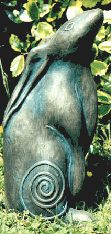
The following is excerpted from Rumi: The Book of Love: Poems of Ecstasy and Longing by Coleman Barks.
____________________________
I like to think of the first mystical poem as that figure incised, and painted, into the farthest wall of the cave called Les Trois Freres in southern France. The Animal. Joseph Campbell called him “god of the cave.” He does the dance of human and animal at once, owl, lion, horse, stag, man. He incorporates them all visually and looks out at you with your own menagerie, who have gone inward far enough to meet his gaze. Animals can live inside the landscape without our noisy self-consciousness. When we turn and go with them . . . we enter a silence and a transcendence. We perceive through their eyes with their energies. This is a metaphor, a tremendously important one, as well as an experience.
Hazrat Inayat Khan says that seekers should “accomplish their desires that they may thus be able to rise above them to the eternal goal.” At the core of each person’s nature are unique seeds of desiring, which flourish through the development of personality, not through any suppression of it. We are not to become pale renunciate ciphers with no wantings. The animals of desiring . . . are not to be thwarted but lived, transmuted, and incorporated. This is the art of forming a personality.

Only when we live the animal powers do we learn that those satisfactions are not what we truly wanted. There’s more, and we are here to follow the mysteries of longing beyond where they lead. The purpose of desire is to perfect the longings, for at the core of longing is the Friend, Christ, Krishna, the emptiness, wherever it was that Igjargajuk, the Eskimo shaman, was when he came back from forty nights on the ice floes with one sentence: “There is nothing to fear in the universe.” The great love at the center of longing has no fear in it . . .
There is a witness who watches the obstreperous play of flame and eros and says, This is the dance of existence. A great mutual embrace is always happening between the eternal and what dies, between essence and accident. We are all writing the book of love. Everything goes in. All the particles of the world are in love and looking for lovers. Pieces of straw tremble in the presence of amber. Isn’t that the deal? We’re here to love each other, to deepen and unfold that capacity, to open the heart . . .

This region of animal energies is where sexuality enters love’s book most obviously, although eros, as Freud showed, is a powerful ingredient in many motions that draw us. Sex is a basic and nourishing to human beings as baking bread. Rumi implies as much in the heroic simile of the breadmaking poem. Lovemaking is going on everywhere among the forms, and in a startling variation of the golden rule he says, Remember, the way you make love is the way God will be with you.
Opening image: “Full Moon” by Hannah Giffard.













































